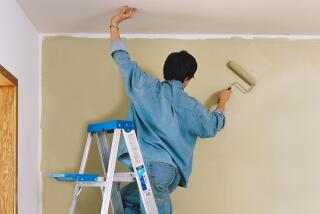In 2003, We’ll Be Feeling Blue and Seeing Red
Ever wonder why every other car you see is silver? Or why we had avocado green refrigerators in the 1960s and mauve hotel rooms in the ‘80s? Part of the blame--or credit--can be given to the 1,700-member international Color Marketing Group, a nonprofit, Virginia-based association that has dictated color trends since 1962.
“Our global membership studies demographics, lifestyles, age groups, economics and politics to determine which colors will be prominent in years to come,” explains member Laraine Turner of Long Beach-based Jolley-Turner Group Inc., a design and color-consulting firm.
At the Color Marketing Group’s meeting last April, they decided on the color trends for 2003. So what can we expect?
Blue will be the dominant color in 2003, but not just one hue. Among the choices will be “cinder blue” (gray-blue), “blue aire” (retro ‘60s turquoise blue), “deep arctic” (conservative navy) and “ocean cruise” (watery pastel blue). “Blues become important when people spend more time at home because blue is calming,” Turner says. She predicts blue also will be pushed into other colors like green, gray and red because of their soothing effect and our fascination with air, light, space and water. A dusty-rose form of mauve will return, as will violet, both on the blue side.
Nature colors like tropical greens and copper-based browns will also be popular. “Colors will be more subtle and complex in nature,” she says. Color Marketing’s “silger,” a gold-silver special effect, is a strong forecast for fashion.
“It used to be that one color drove everything,” explains Turner, citing the 1950s love of pink as an example. “That doesn’t happen anymore because the global culture has changed things. Now there are groups of colors.
“At our October meeting, we talked about the impact of 9/11,” says Turner, “and we felt that we’d continue to see a lot of red, white and blue. That was happening even before 9/11, because of the popularity of books like the John Adams biography.”
Turner thinks there will be fewer color choices because of economic cutbacks. “Where maybe a manufacturer would offer eight colors--four safe and four either trendy or extremely trendy--now there will probably only be four or five,” she said.
In the home, berry tones like raspberry, pink-reds and currant (brown-violet) will be used. Accent colors include peach, orange and lemon-golds. “It used to be that carpet colors ran the market because the carpeting was the most expensive item, so it was done first and everything was built around it,” Turner says. “Today’s designers are using hard surfaced floors like tile and wood, so upholstery fabrics now come first. This makes it easier to change colors, since you can remove slipcovers, rotate pillows, add throw rugs without that much expense.
“For cars, the colors will be very conservative. It’s almost a back to the ‘70s time,” Turner says. “Basically there will be red, blue, gray, white, black. Some cars will feature pearlescent and silver-tinted whites, as well as metallic golds.”
In public spaces like hotels and stores, colors will be muted. Expect to see buttery yellows, soft limes, gold neutrals, gold-greens. “The colors will not be edgy,” Turner says. “Instead they will be softer and more complex.”
The one area where bright colors will shine is in industry. Color Marketing sees high-energy colors for high-tech companies. Turner says that retro colors will still be popular in this area, so sweetheart red, Victorian rose and bright turquoise with orange or peach will be on items such as dishes and appliances.
“A bright red mixer was the hit of the recent appliance expo in Chicago,” Turner says.
“Color isn’t just color,” she adds. “Technology has allowed for a lot of changes, so color is texture, finish, translucence, pearlescence, metallic. There are also interference pigments where the angle from which you view the object changes the color.”
What’s next for Color Marketing? High-tech, pearlized crystal balls?
*
Walking Tour of the
Miracle Mile Area
On Saturday, a Miracle Mile walking tour will take place at 10 a.m. Fee is $5-$10; reservations required at Art Deco Society of L.A., (310) 659-3326.
On Sunday, Butterfields’ and Los Angeles Modern Auctions’ 20th century furniture and decorative arts sale includes examples from private and corporate collections. Among the more than 500 lots are a custom-designed Kiesler table (estimated to sell for more than $100,000), Danish Modern pieces designed in the late 1940s and early ‘50s and vintage posters.
Multiple lots from a Midwest collector feature art glass and furniture, including George Nelson designs.
Among the art glass pieces are a Picasso vase, several Tiffany studio lamps, and American and European pieces by Rookwood, Lalique and Galle. Furniture includes pieces by Alvar Aalto and Charles and Ray Eames.
Flatware, earthenware, dinnerware and chairs by Russel Wright also will be up for auction. Bidding starts at 10 a.m. Butterfields is at 7601 Sunset Blvd., (323) 850-7500, www.butterfields.com.
On Tuesday, Jo Hormuth of Chicago Architectural Arts speaks on “Creating the Craftsman Style Interiors at Crab Tree Farm.” The 7:30 p.m. lecture is $10-$15; Gamble House, 4 Westmoreland Place, Pasadena. Reservations required. (626) 793-3334, www.gamble house.org.
*
Kathy Bryant can be reached at kbryant@socal.rr.com.
More to Read
Sign up for our Book Club newsletter
Get the latest news, events and more from the Los Angeles Times Book Club, and help us get L.A. reading and talking.
You may occasionally receive promotional content from the Los Angeles Times.







